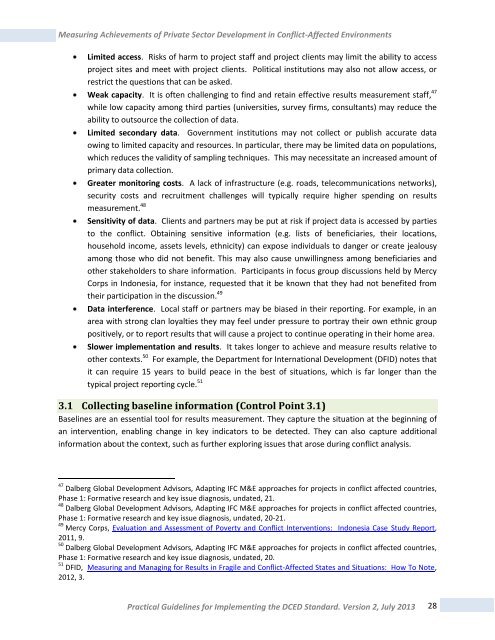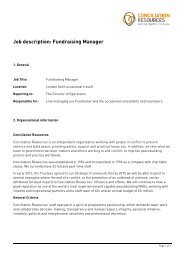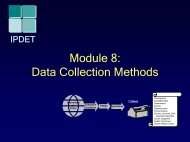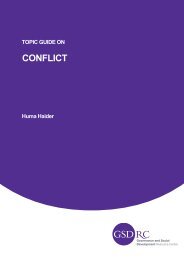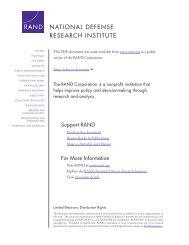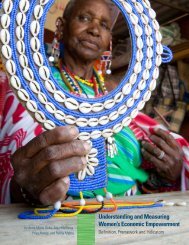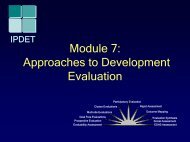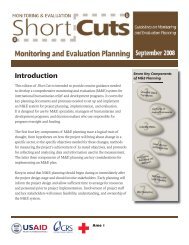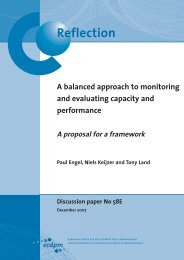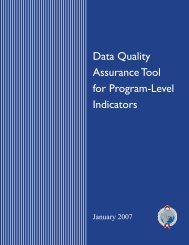Measuring Achievements of Private Sector Development in ... - DCED
Measuring Achievements of Private Sector Development in ... - DCED
Measuring Achievements of Private Sector Development in ... - DCED
You also want an ePaper? Increase the reach of your titles
YUMPU automatically turns print PDFs into web optimized ePapers that Google loves.
<strong>Measur<strong>in</strong>g</strong> <strong>Achievements</strong> <strong>of</strong> <strong>Private</strong> <strong>Sector</strong> <strong>Development</strong> <strong>in</strong> Conflict-Affected Environments<br />
Limited access. Risks <strong>of</strong> harm to project staff and project clients may limit the ability to access<br />
project sites and meet with project clients. Political <strong>in</strong>stitutions may also not allow access, or<br />
restrict the questions that can be asked.<br />
Weak capacity. It is <strong>of</strong>ten challeng<strong>in</strong>g to f<strong>in</strong>d and reta<strong>in</strong> effective results measurement staff, 47<br />
while low capacity among third parties (universities, survey firms, consultants) may reduce the<br />
ability to outsource the collection <strong>of</strong> data.<br />
Limited secondary data. Government <strong>in</strong>stitutions may not collect or publish accurate data<br />
ow<strong>in</strong>g to limited capacity and resources. In particular, there may be limited data on populations,<br />
which reduces the validity <strong>of</strong> sampl<strong>in</strong>g techniques. This may necessitate an <strong>in</strong>creased amount <strong>of</strong><br />
primary data collection.<br />
Greater monitor<strong>in</strong>g costs. A lack <strong>of</strong> <strong>in</strong>frastructure (e.g. roads, telecommunications networks),<br />
security costs and recruitment challenges will typically require higher spend<strong>in</strong>g on results<br />
measurement. 48<br />
Sensitivity <strong>of</strong> data. Clients and partners may be put at risk if project data is accessed by parties<br />
to the conflict. Obta<strong>in</strong><strong>in</strong>g sensitive <strong>in</strong>formation (e.g. lists <strong>of</strong> beneficiaries, their locations,<br />
household <strong>in</strong>come, assets levels, ethnicity) can expose <strong>in</strong>dividuals to danger or create jealousy<br />
among those who did not benefit. This may also cause unwill<strong>in</strong>gness among beneficiaries and<br />
other stakeholders to share <strong>in</strong>formation. Participants <strong>in</strong> focus group discussions held by Mercy<br />
Corps <strong>in</strong> Indonesia, for <strong>in</strong>stance, requested that it be known that they had not benefited from<br />
their participation <strong>in</strong> the discussion. 49<br />
Data <strong>in</strong>terference. Local staff or partners may be biased <strong>in</strong> their report<strong>in</strong>g. For example, <strong>in</strong> an<br />
area with strong clan loyalties they may feel under pressure to portray their own ethnic group<br />
positively, or to report results that will cause a project to cont<strong>in</strong>ue operat<strong>in</strong>g <strong>in</strong> their home area.<br />
Slower implementation and results. It takes longer to achieve and measure results relative to<br />
other contexts. 50 For example, the Department for International <strong>Development</strong> (DFID) notes that<br />
it can require 15 years to build peace <strong>in</strong> the best <strong>of</strong> situations, which is far longer than the<br />
typical project report<strong>in</strong>g cycle. 51<br />
3.1 Collect<strong>in</strong>g basel<strong>in</strong>e <strong>in</strong>formation (Control Po<strong>in</strong>t 3.1)<br />
Basel<strong>in</strong>es are an essential tool for results measurement. They capture the situation at the beg<strong>in</strong>n<strong>in</strong>g <strong>of</strong><br />
an <strong>in</strong>tervention, enabl<strong>in</strong>g change <strong>in</strong> key <strong>in</strong>dicators to be detected. They can also capture additional<br />
<strong>in</strong>formation about the context, such as further explor<strong>in</strong>g issues that arose dur<strong>in</strong>g conflict analysis.<br />
47 Dalberg Global <strong>Development</strong> Advisors, Adapt<strong>in</strong>g IFC M&E approaches for projects <strong>in</strong> conflict affected countries,<br />
Phase 1: Formative research and key issue diagnosis, undated, 21.<br />
48 Dalberg Global <strong>Development</strong> Advisors, Adapt<strong>in</strong>g IFC M&E approaches for projects <strong>in</strong> conflict affected countries,<br />
Phase 1: Formative research and key issue diagnosis, undated, 20-21.<br />
49 Mercy Corps, Evaluation and Assessment <strong>of</strong> Poverty and Conflict Interventions: Indonesia Case Study Report,<br />
2011, 9.<br />
50 Dalberg Global <strong>Development</strong> Advisors, Adapt<strong>in</strong>g IFC M&E approaches for projects <strong>in</strong> conflict affected countries,<br />
Phase 1: Formative research and key issue diagnosis, undated, 20.<br />
51 DFID, <strong>Measur<strong>in</strong>g</strong> and Manag<strong>in</strong>g for Results <strong>in</strong> Fragile and Conflict-Affected States and Situations: How To Note,<br />
2012, 3.<br />
Practical Guidel<strong>in</strong>es for Implement<strong>in</strong>g the <strong>DCED</strong> Standard. Version 2, July 2013<br />
28


